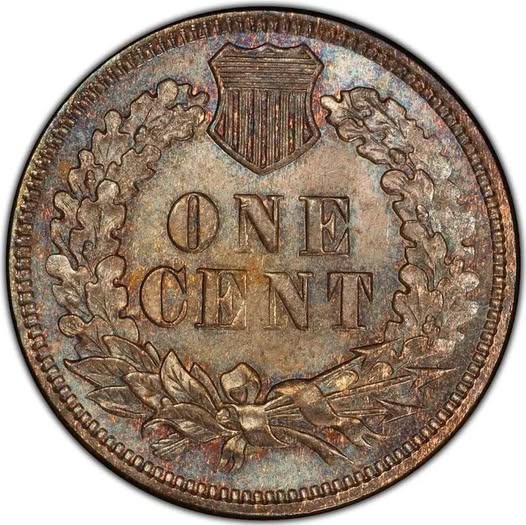
Like most coins, the United States penny has seen multiple designs and compositions over the years, and some pennies, especially when carefully stored, are worth far more than the face value of one cent.
These are the 20 most valuable pennies, and they’re worth a combined $5.5 million.
How to Determine the Value of a Penny
:quality(80)/granite-web-prod/25/31/253147e45cf748f1883bdbd0b8a732f4.png)
Standards have been developed to evaluate coins. A modified version of the Sheldon Scale, which grades coins on a scale from 1 to 70 (with 70 being the most valuable), is commonly used. Qualities such as color (red pennies are worth more than red-brown or brown ones), wear and rarity (including smaller numbers minted or mistakes) impact a coin’s grade.
For most pennies, those minted in recent years are worth, well, a penny. Most wheat cents (wheat pennies were minted between 1909 and 1956) are worth about 4 to 5 cents. Those in better condition can have double-digit values. Special examples (especially those in near-perfect condition) can be worth much more. Indian Head pennies from 1859 to 1879 are generally worth more than $10. And pennies dated from 1879 to 1909 are worth at least $1.
Then, there is another level. This is the elite class of valuable collectibles.
20. 1873 Doubled ‘Closed 3’ Indian Head Penny
:quality(80)/granite-web-prod/23/56/23566549feb840068e8e52e4c5e112e6.jpeg)
Bottom Line: 1873 Doubled ‘Closed 3’ Indian Head Penny
:quality(80)/granite-web-prod/c4/03/c403c3d8ee0c4572801e9ad652bf24ba.jpeg)
This coin is also more valuable due to doubling, as seen in the word “LIBERTY.” There were only about 1 million of these “closed 3” coins and about 11 million “open 3” coins.
The open and closed designations refer to the amount of space in the number “3” on the coin, depending on which variety of the numeral was used in the die.
One of these with a red-brown coloration and in almost uncirculated condition sold at a Heritage Auction in Pittsburgh, Pennsylvania, in October 2011.
19. 1793 Flowing Hair Liberty Cap Large Cent Penny
:quality(80)/granite-web-prod/3b/1b/3b1b0e14368345dfaa0ff01e828eb233.png)
Sold on eBay: $19,950
Weight: 13.48 grams
Metal: Copper
Bottom Line: 1793 Flowing Hair Liberty Cap Large Cent Penny
:quality(80)/granite-web-prod/ad/b0/adb043b92c5f482a86d0bb867c305a0b.png)
The Flowing Hair large cent was produced starting in 1793. The Liberty Cap style was the third version of the Flowing Hair coin.
It was introduced late in 1793 and was produced until 1796 when it was replaced by the Draped Bust type.
Because of its rarity, even with smoothed surfaces, this one sold on eBay in January 2019 for almost $20,000.
18. 1922 Lincoln No D Strong Reverse and Weak Obverse Wheat Penny
:quality(80)/granite-web-prod/97/a7/97a7d2039e7b48e6b17744b8ee240632.jpeg)
Bottom Line: 1922 Lincoln No D Strong Reverse and Weak Obverse Wheat Penny
:quality(80)/granite-web-prod/1c/88/1c883bf43e0644adb1efbffd24f849bf.jpeg)
Like the 1922-D Lincoln, No D, Strong Reverse, Die Pair 2, this coin is missing the mint mark on the face of the coin.
However, the reverse image on this coin is not as sharp.
In March 2018, Heritage Auctions sold one in excellent condition.
17. 1922-D Lincoln, No D, Strong Reverse, Die Pair 2
:quality(80)/granite-web-prod/50/69/5069a7980ae246fab4b5ec97060c6f61.jpeg)
Bottom Line: 1922-D Lincoln, No D, Strong Reverse, Die Pair 2
:quality(80)/granite-web-prod/5f/25/5f25a59599114da985ecbdcd8980dae7.jpeg)
One or more damaged die at the Denver Mint resulted in coins struck without a mint mark. While most coins without a mark are from the Philadelphia Mint, Denver was the only mint to strike pennies in 1922.
It is believed that about 15,000 to 20,000 coins were produced in this way. The image on the reverse is sharper than that on the face since the die used for the reverse was a fresh one.
A red coin in mint condition sold in Baltimore, Maryland, in March 2018.
16. 1914-S Lincoln Penny
:quality(80)/granite-web-prod/79/14/7914ca8b5a364f538441cc788ba8fb05.jpeg)
Bottom Line: 1914-S Lincoln Penny
:quality(80)/granite-web-prod/d3/b9/d3b9625ea1b94b73af7ad30f6f21c92b.jpeg)
Over 4 million of these pennies were minted at the San Francisco Mint (hence the S designation).
This one appears to be uncirculated and properly stored to avoid wear and retain its bright copper-red color.
In August 2006, Bowers & Merena sold the pristine penny in its original bright color.
15. 1944-D Lincoln Penny
:quality(80)/granite-web-prod/4a/48/4a486ede0a2d4cf9aa89140864088c4c.jpeg)
Bottom Line: 1944-D Lincoln Penny
:quality(80)/granite-web-prod/77/af/77af50384a9d41f7b0c5eb3263c77662.jpeg)
This penny is another “mistake.” It was struck on a zinc-coated steel planchet, or coin blank, which had been used in 1943. The mint returned to using copper planchets in 1944.
While there are examples of this coin in zinc from both the Philadelphia and Denver Mints, it is estimated that there are no more than 10 from Denver.
In August 2007, Heritage Auctions sold an uncirculated one.
Bottom Line: 1969-S Lincoln Penny Doubled Die Obverse
:quality(80)/granite-web-prod/1f/f1/1ff1a82f68674569801ce5190c91c901.jpeg)
Lincoln pennies that were minted between 1959 and 1982 tend to be worth more since they are almost 100 percent copper, rather than an alloy. Improperly prepared dies can result in coins with a “double” image.
The most well-known was in 1955, but this also occurred in coins dated 1917, 1936, 1958, 1969-S, 1971, 1971-S, 1972 and 1995. Originally believed to be counterfeit, the government destroyed five coins before acknowledging the error.
In January 2008, a doubled die obverse uncirculated penny, red-brown in color, sold at Heritage Auctions in Orlando, Florida.
13. 1872 Indian Head Penny
:quality(80)/granite-web-prod/f7/d7/f7d7cff79879494a82d574aaa742cffe.jpeg)
Bottom Line: 1872 Indian Head Penny
:quality(80)/granite-web-prod/0e/17/0e17091abbce4464a543f2d76d71eb81.jpeg)
More than 4 million of these coins were minted, but they were inconsistent in quality, so problem-free examples are fairly rare.
This particular coin was not only in excellent condition but was also struck from a fresh set of coin dies.
In August 2007, it was sold by Heritage Auctions in Milwaukee, Wisconsin.
12. 1926-S Lincoln Penny
:quality(80)/granite-web-prod/76/7f/767fe5fa3362435ebd074564080c5285.jpeg)
Bottom Line: 1926-S Lincoln Penny
:quality(80)/granite-web-prod/f7/07/f7070891dbc6462d82f5613e3ee12478.jpeg)
Heritage Auctions in Orlando sold the uncirculated 1926 penny in January 2006.
While the excellent condition makes it valuable, it would be worth something even in worse condition since only nine other wheat pennies were produced in lesser quantities.
Bottom Line: 1877 Indian Head Penny
:quality(80)/granite-web-prod/3d/6e/3d6edb3b53a2443981081d92a953ff03.jpeg)
This is the rarest Indian Head penny.
Due to an economic slump that began in 1873, only 852,500 were made.
In August 2007, one in its original copper-red color was sold by Heritage Auctions in Milwaukee.
10. 1914-D Lincoln Penny
:quality(80)/granite-web-prod/d3/f7/d3f770080bbb4a64b2a86f7238d53e62.jpeg)
Bottom Line: 1914-D Lincoln Penny
:quality(80)/granite-web-prod/c4/0d/c40dfcbd777541b685a8265db2811c7b.jpeg)
Though it had a mintage of just over 1 million (which is low for a penny), most of these coins went into circulation, so a mint-condition example is rare.
The scarcity of this coin increases its value. Even those in less-than-perfect condition may be worth $125 or more.
In May 2018, an uncirculated, red Denver Mint penny was sold online by Legend Rare Coin Auctions.
9. 1864 Indian Head Penny With ‘L’ on the Ribbon
:quality(80)/granite-web-prod/20/83/2083e3376eb2435596f6fa4beda20585.jpeg)
Bottom Line: 1864 Indian Head Penny With ‘L’ on the Ribbon
:quality(80)/granite-web-prod/e3/10/e310461acaa8497994255f0a00a96796.jpeg)
The Indian Head penny design dates back to 1859. During the Civil War, the government had difficulty obtaining metal for coins, so halfway through 1864, they switched from a copper-nickel mix to a bronze alloy. Also halfway through the year, an “L” was added to the tail of the ribbon in Lady Liberty’s war bonnet.
About 5 million of these coins were made, and only a few remain in uncirculated condition.
This one was sold by Heritage Auctions in Pittsburgh in October 2011.
Bottom Line: 1856 Flying Eagle Penny
:quality(80)/granite-web-prod/64/c7/64c70065f86b40b382581726e03e0939.jpeg)
In 1856, the price of copper made a penny cost more than one cent to produce, so the U.S. Mint decided to reduce the size to what we now see. Prior to this, the coin was 19 millimeters in diameter, almost as big as the current nickel.
The Flying Eagle design was only produced from 1856 to 1858. In 1856, only 2,000 were made.
In January 2004, Heritage Auctions in Orlando sold one in pristine condition
7. 1943 Bronze Lincoln Penny
:quality(80)/granite-web-prod/ac/50/ac50e3884ffa48acb77b0d39e4fd50b8.jpeg)
Bottom Line: 1943 Bronze Lincoln Penny
:quality(80)/granite-web-prod/7b/7c/7b7cf6993b6f43e1ae0de57414c6443b.jpeg)
While the condition of this particular coin is not mint, this penny has the distinction of being the one that caused the U.S. Mint to admit that some pennies were mistakenly minted in bronze that year.
In 1947, a teen found this in his pocket change from a high school cafeteria. This is one of only 10 to 15 examples of these pennies known to exist, and this particular coin was sold for the first time by Heritage Auctions in Florida in January 2019.
In January 2013, another 1943 bronze penny, in its original copper-red color, was sold by Stack Bowers Galleries for $164,500.
6. 1909 V.D.B. Matte Proof Lincoln Penny
:quality(80)/granite-web-prod/0a/d0/0ad0452ef6ce40539149977a164d87e4.jpeg)
Bottom Line: 1909 V.D.B. Matte Proof Lincoln Penny
:quality(80)/granite-web-prod/19/d6/19d6b9b02f5f4ad9bfe78ffdacfb6e6a.jpeg)
The first Lincoln pennies were made in 1909. The coins initially included the initials of the designer, “V.D.B.,” on the bottom of the rear side of the coin. After some complaints about their prominence, these initials were removed for future coins.
While there are more than half a million pennies that include V.D.B., this particular penny was created using a matte proof die (used for fewer strikes than a traditional die). Only 1,194 of these proofs were struck before the initials were removed.
In August 2014, Heritage Auctions in Chicago, Illinois, sold one in excellent condition.
5. 1943-S Lincoln Cent
:quality(80)/granite-web-prod/3f/c0/3fc0a3e1840747d19b046bc5ef45c48c.jpeg)
Bottom Line: 1943-S Lincoln Cent
:quality(80)/granite-web-prod/1f/9a/1f9a6ae8668a41fbb58d88fc8db68996.jpeg)
This is another 1943 Lincoln cent that should have been struck on a zinc-plated steel planchet but was instead coined in bronze.
One of six known examples produced at the San Francisco Mint, it is said to be the “second-finest certified 1943-S bronze cent.”
It sold at Heritage Auctions in Long Beach, California, in February 2016.
4. 1958 Doubled Die Obverse Lincoln Penny
:quality(80)/granite-web-prod/a9/ee/a9ee1caa95394e909f21cab902d8ef39.jpeg)
Bottom Line: 1958 Doubled Die Obverse Lincoln Penny
:quality(80)/granite-web-prod/d4/c2/d4c24ac3ce36436f88a7c3752a51ae63.jpeg)
A doubled die coin is the result of a minting error. On these coins, part of the image appears to be “double.”
This penny has a strong doubling of the wording on the face, and since only three of these coins are known to exist, it is extremely rare. Adding to the penny’s value, this example is also red in color.
It sold at Stacks Bowers Galleries Auction at the Baltimore Coin Show in March 2018.
Bottom Line: 1944-S Lincoln Steel Penny
:quality(80)/granite-web-prod/43/9e/439efcbb12e647b8add8373e13962134.jpeg)
In 1944, all Lincoln pennies were supposed to be once again minted in the original bronze alloy (95 percent copper and 5 percent tin).
Somehow, zinc-plated steel planchets (used in 1943) ended up in the coining press, surprisingly in all three mints.
An uncirculated coin in zinc sold in August 2008 at Heritage Auctions in Baltimore.
2. 1943 Bronze Lincoln Penny
:quality(80)/granite-web-prod/ed/0c/ed0c15e9bf7f4d5b87193b3c154ca7dd.jpeg)
Bottom Line: 1943 Bronze Lincoln Penny
:quality(80)/granite-web-prod/a4/0c/a40c3090523647fa91ea757afa37845f.jpeg)
Like the 1943-D Lincoln Bronze Penny, this penny was mistakenly minted in bronze.
While other of these bronze coins were produced at this mint, this coin is the only certified “red” penny of this year to be coined at the Philadelphia Mint. (Coins minted in Philadelphia have no mint mark.)
It sold in a private sale in Tampa, Florida, in 2018.
1. 1943-D Lincoln Bronze Penny
:quality(80)/granite-web-prod/02/43/02432309320e4dbea1529cb577cb7e09.jpeg)
Bottom Line: 1943-D Lincoln Bronze Penny
:quality(80)/granite-web-prod/ab/de/abde42d037d84361bd0868a21cbfb0ea.jpeg)
There’s only one known example of a 1943 Lincoln-D penny struck in bronze alloy instead of zinc-plated steel (bronze and copper were being saved to fill metal shortages during World War II).
Though there’s no record of any other bronze 1943 pennies minted in Denver (indicated by the “D” on the coin), up to 20 examples may have been struck on the bronze alloy at each of the Philadelphia and San Francisco Mints.
This particular coin sold in September 2010 in a private sale by Legend Numismatics of Lincroft, New Jersey.
Check Your Pocket Change for Pennies Worth Money
:quality(80)/granite-web-prod/52/60/5260300d600042e9969477d15e22bd8e.png)
Most of the pennies in your pocket are not worth much more than face value. But as you can see, some can fetch real dollars.
So check your pocket change. If you find one of these coins, don’t even think about spending it.
That penny could make you a millionaire.
:quality(80)/granite-web-prod/7b/2d/7b2df0b766a04e3eac038ee283a9d66e.jpeg)
:quality(80)/granite-web-prod/5e/bb/5ebb027a2cc749e8a89dd1ae23ff24a8.jpeg)
:quality(80)/granite-web-prod/19/13/1913796ad48a4467a7ef613d31b0da9b.jpeg)
:quality(80)/granite-web-prod/29/a1/29a12db92d814f2fba2b9ace43781137.jpeg)


